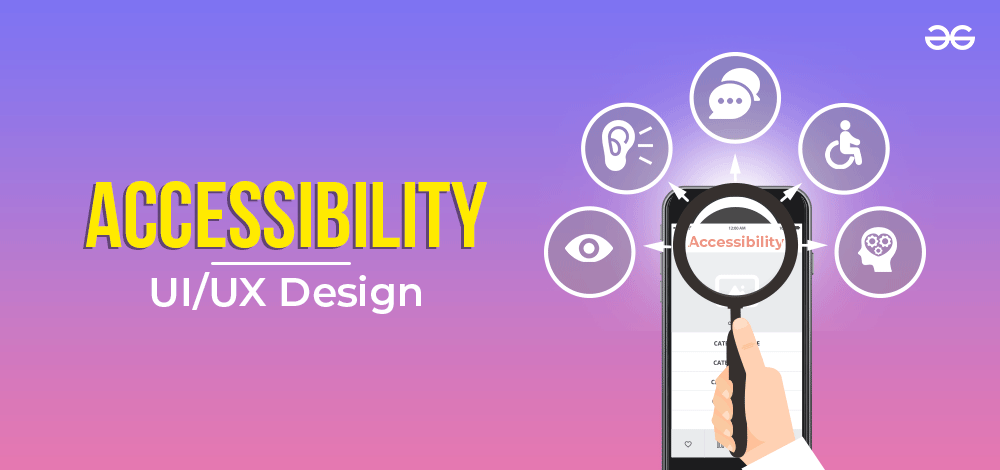A comprehensive resource article, on the topic “The Complete Guide for Accessibility in UI/UX Design” seeks to provide designers, developers, and product managers with the skills and resources required to construct inclusive and user-friendly digital experiences. Modern design must be accessible in order for people of all abilities to use and interact with digital goods and services without difficulty.
We’ll be covering the fundamental Concept of Accessibility, Principles, and Laws across the globe, and recommended methods for integrating accessibility into each step of the UI/UX design process. Organizations can embrace accessibility in UI/UX design to meet legal obligations as well as reach a wider audience, boost user engagement, and promote inclusivity and empathy. This article is an essential tool for developing digital experiences that leave no one behind, regardless of your level of design expertise or where you are in your career.
What is Accessibility?
The practice of ensuring that products, content, and applications are useful and accessible to individuals with disabilities is known as Accessibility, in the context of technology and design. In UI/UX Design, Accessibility aims to give people with disabilities the same opportunities, a similar user experience, and the ability to fully participate in society as people without disabilities. There are many different facets of accessibility, such as digital material, physical spaces, transportation, and more.
Let’s have a look into Accessibility and its type in detail:
Digital Accessibility
- Web Accessibility: It is concerned with facilitating the use of websites and web applications by individuals with disabilities. Assistive technology compatibility is improved by using semantic HTML, providing captions for movies, assuring keyboard navigation, and building websites that can be navigated by screen readers.
- Software and Mobile Apps: Designing user interfaces that can be handled using a variety of input methods, such as touch, voice, or keyboard, is an important component of accessibility in software and mobile apps. It also entails supporting accessibility features on multiple operating systems and providing text equivalents for non-text information.
- Document Accessibility: Creating accessible documents means ensuring that text documents (e.g., PDFs) are readable by screen readers, and multimedia presentations (e.g., PowerPoint slides) are designed to accommodate individuals with hearing or visual impairments.
Physical Accessibility
- Architectural Design: Including amenities like ramps, larger entrances, and accessible restrooms in the design of public buildings and places makes them wheelchair-friendly. Parking areas and entrances are also accessible.
- Accessible Transportation: Alternatives include ramps or lifts on buses, trains, and airplanes, special seating sections for people with disabilities, and audible stop announcements.
Communication Accessibility
- Sign Language Interpretation: Having sign language interpreters available for those who are hard of hearing or deaf is essential for productive interaction in a variety of contexts, including conferences, open forums, and professional consultations.
- Captioning and Subtitling: People who are deaf or have hearing difficulties, as well as those who might not understand the spoken language, benefit from adding captions and subtitles to videos and live presentations.
The goal of accessibility is to make all people accessible to UI, including those with impairments. Making information, services, and physical environments accessible to everyone entails careful design, adherence to standards, and the use of technology. This encourages equality, independence, and involvement in all facets of life. Additionally, accessibility is not only a legal need but also a moral and ethical responsibility that promotes diversity and inclusivity and helps society as a whole.
Disability, Design & Society
In order to develop inclusive and accessible digital goods and services for people with disabilities, the field of design known as UX (User Experience) design has made disability, design, and society a crucial area of attention. It takes into account the various requirements and capacities of users and aims to remove obstacles that can impede people with disabilities from fully interacting with the digital environment.
Disability
Any physical, cognitive, sensory, or mental impairment that may significantly reduce a person’s capacity to engage in daily activities or interact with their environment is referred to as a disability. Disabilities can range considerably from person to person and might be permanent, transitory, or situational. Examples of widespread disabilities include those related to vision, hearing, motor skills, cognition, and neurodiversity (such as autism spectrum disorders).
How Society Perceives Disability?
There exist 2 models via which the society perceives any disability:
- The Medical Model of Disability: In this the society takes disability as a medical condition which can’t be reversed and where the user is the cause of the disability. Society typically places the complete responsibility, and burden on the user to deal with it. Mentioning that “One needs help, cures and precautions to be a normally functioning human being.”
- The Social Model: In this the society takes the charge of someone’s disability on themselves saying that “Society is the cause for Disability”. This model describes disability as an environment, social or attitudinal barrier to a person from being able to function like any other normally abled human being could. Mentioning that society is the reason for someone’s disability.
Accessibility Laws and Guidelines
The laws and regulations governing accessibility differ from nation to nation, and many regions have their own unique laws that deal with the inclusion and accessibility of digital goods and services. Let us explore some ssential Accessibility Laws and Guidelines
Accessibility Laws
- Americans with Disabilities Act (ADA) (United States): The ADA prohibits discrimination against individuals with disabilities in all areas of public life, including employment, transportation, public accommodations, and digital services.
- Japanese Industrial Standard (JIS X 8341-3) (Japan): JIS X 8341-3 is a Japanese standard for web accessibility, aligning with WCAG guidelines.
- Disability Discrimination Act (DDA) (Australia): The DDA aims to eliminate discrimination against people with disabilities in various areas of public life, including digital services.
- Accessibility Regulations (EU Web Accessibility Directive) (European Union): The EU Web Accessibility Directive requires public sector websites and mobile applications to meet specific accessibility standards based on WCAG.
- Section 508 (United States): Section 508 is an amendment to the Rehabilitation Act of 1973 and requires federal agencies in the United States to make their electronic and information technology accessible to people with disabilities.
- Equality Act 2010 (United Kingdom): The Equality Act 2010 prohibits discrimination against individuals with disabilities and requires organizations to make reasonable adjustments to ensure accessibility.
- Canadian Accessibility Act (Canada): This law aims to create a barrier-free Canada for people with disabilities by setting accessibility standards for the federal government and organizations under federal jurisdiction.
- Standard EN 301 549 (European Union): This standard outlines the accessibility requirements for public procurement of ICT products and services in the European Union.
- Accessibility for Ontarians with Disabilities Act (AODA) (Ontario, Canada): The AODA sets accessibility standards for organizations in Ontario to identify, remove, and prevent barriers for people with disabilities.
Accessibility Guidelines
- Web Content Accessibility Guidelines (WCAG) (International): While not a law itself, WCAG is a set of guidelines developed by the Web Accessibility Initiative (WAI) of the World Wide Web Consortium (W3C) and is widely used as a standard for web accessibility across the globe. Addresses: Text, Font size, Color, sound and Images
- Authoring Tool Accessibility Guidelines (ATAG) (International): Provides guidance to developers, designers, and manufacturers of web authoring tools, helping them create accessible authoring tools that enable content creators to produce accessible web content. Two layers of ATAG, each addressing various facets of writing tool accessibility
- ATAG Level A: Level A conformance consists of the fundamental rules intended to meet users’ most fundamental accessibility requirements. Authoring tools must facilitate the development of accessible content, and it helps content creators comprehend and use accessibility features.
- ATAG Level AA: Level AA conformance extends Level A’s requirements and adds new recommendations to improve authoring tool accessibility. With sophisticated features and advice, it offers content creators more thorough assistance in producing accessible material.
- User Agent Accessibility Guidelines (UAAG) (International): Ensures that web browsers, media players, and other user agents are developed and deployed in ways that enhance accessibility for individuals with disabilities. This document contains recommendations for developers and manufacturers of user agents. User agents are computer programmes that let people engage with web content. Web browsers, media players, email clients, and other programmes that render or process web content fall under this category.
Conclusion
In the end, I would say that this article would be a useful resource and road map for developing inclusive and user-centered digital experiences as the entire guide for accessibility in UI/UX design.Designers may make sure that their products cater to a wide range of users, including those with disabilities, by including accessibility principles into the design process. In the end, UI/UX design that prioritizes accessibility benefits not only those who have disabilities but also improves the entire user experience for all users. Creating a digital environment that embraces and celebrates the variety of its users gives designers a special chance to be agents of positive change, assuring that no one is left behind.
Must Check
FAQs: Accessibility in UI/UX Design
1. What is accessibility in UI/UX design?
Accessibility in UI/UX design refers to the practice of creating digital interfaces that can be easily used and understood by people with disabilities. It involves making websites, applications, and other digital products inclusive and usable for everyone, regardless of their abilities or impairments.
2. Why is accessibility important in UI/UX design?
Accessibility is crucial because it ensures that digital products are available and usable by a wider audience, including individuals with disabilities. It promotes inclusivity and compliance with legal and ethical standards.
3. What are some common disabilities that UI/UX designers should consider?
Designers should consider a range of disabilities, including visual impairments, hearing impairments, motor disabilities, cognitive impairments, and more. Each disability may require specific design considerations.





